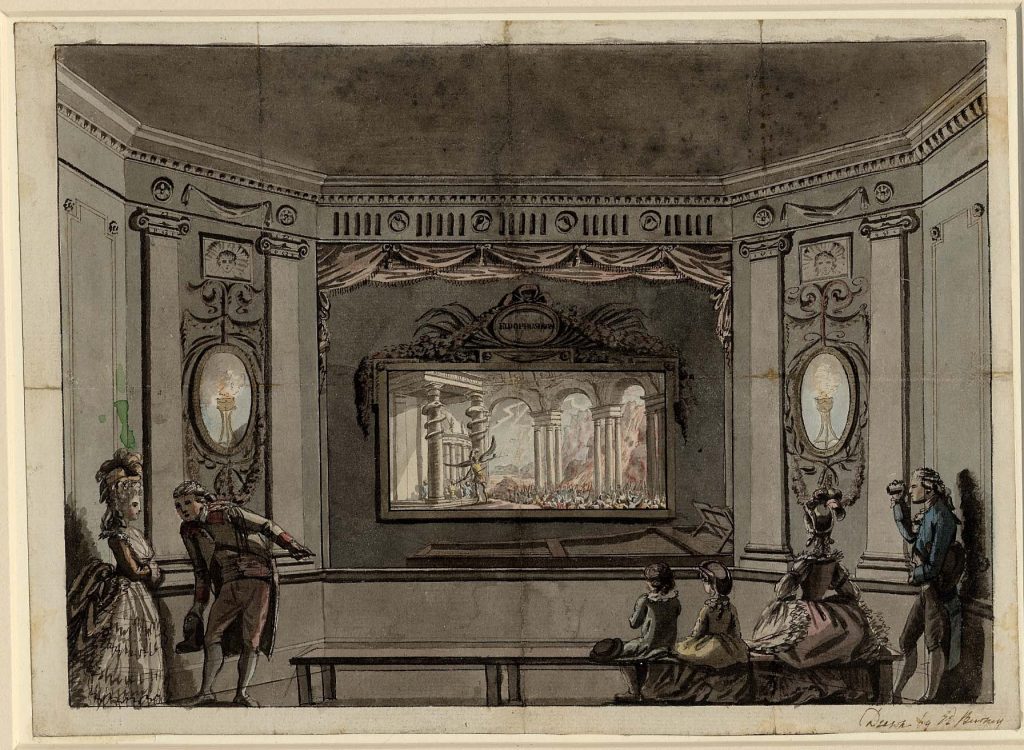The Swedenborg Residency
Gillian McIver is currently Artist and Researcher in Residence at the Swedenborg Centre, the locus of the Swedenborg Society in London.
The Swedenborg Residency will involve researching the life and work of the remarkable Philip James de Loutherbourg, a little-known but tremendously influential artist. The residency outcomes are threefold: creating a version of his remarkable ‘Eidophusikon’ mechanical theatre, writing and producing Apologia, a play about the life of his close friend and associate Count Alessandro Cagliostro, and writing a graphic novel: The Mystagogue: the Life and Times of Philip James de Loutherbourg Artist and Alchemist.
The research will be the foundation of my forthcoming biography of Loutherbourg.
Follow the residency on my blog Art and Magick
Into the Sublime: the Eidophusikon Reimagined

‘Into the Sublime: the Eidophusikon Reimagined’ is Artist in Residence Gillian McIver’s reconstruction and reimagining of the iconic Eidophusikon, a milestone in theatre history. It was created in 1781 by the 18th-century French painter Philip James de Loutherbourg RA, who served as a stage designer for David Garrick at Drury Lane, creating sublime stage effects that astounded audiences.
The original Eidophusikon was a small-scale stage set that combined dramatic paintings, lights, gauze, coloured glass, and smoke to create scenic effects. The original was 304.8cm wide; the reinterpretation will be only slightly smaller. Loutherbourg’s effects included panoramas of London, storms at sea, and scenes from Milton’s Paradise Lost. The Eidophusikon was a popular entertainment in London and is widely regarded as a crucial forerunner to cinema.
Gillian’s Eidophusikon will follow Loutherbourg’s plan of a five-scene performance while incorporating current contemporary art (by herself and a number of London and international artists) to explore Swedenborg’s ideas about art and science, material work and the afterlife, and his vision of the Divine. Loutherbourg knew Swedenborg and most likely painted the ascribed portrait, which is helpful and on display at Swedenborg House.
The piece will be shown in the Wynter Room as part of a contextualised exhibition that will explain the piece, its interpretation of the intertwined history of London’s art and theatre, and the contemporary art scene. The Wynter Room will be open to the public; the Eidophusikon itself will be activated with timed and ticketed performances.
The contextual exhibition will be open to all visitors, including Bloomsbury Festival regulars and visitors to Swedenborg House and Bookshop. The performances will primarily appeal to adults, including young adults, who are interested in the following topics: theatre and its history, history, art and its history, painting, London’s theatre history, the relationship between art and technology, the 18th century, mysticism and the esoteric, and contemporary art.
Into the Sublime: the Eidophusikon Reimagined investigates an analogue invention that, in its original form, was cutting-edge technology. Recreating and reinterpreting it allows us, as viewers and artists, to evaluate the role of the human. The work delves into themes of humanity, mortality, and divinity, all of which have been central to human thought from prehistoric times.
What is the Swedenborg Residency?
Swedenborg House is the library, research centre and museum of Emanuel Swedenborg (1688-1772) the philosopher, mystic and scientist who has been a profound influence on generations.
The Swedenborg Residency was initiated in 2009 to create a forum for researchers, musicians, artists, writers, filmmakers, photographers, sculptors and others to engage directly with Swedenborg’s works, his legacy or the Swedenborg Society’s remarkable library, archive and collection.
The research for the residency looks at Emanuel Swedenborg’s relationship with Loutherbourg and Swedenborg’s influence on the arts.